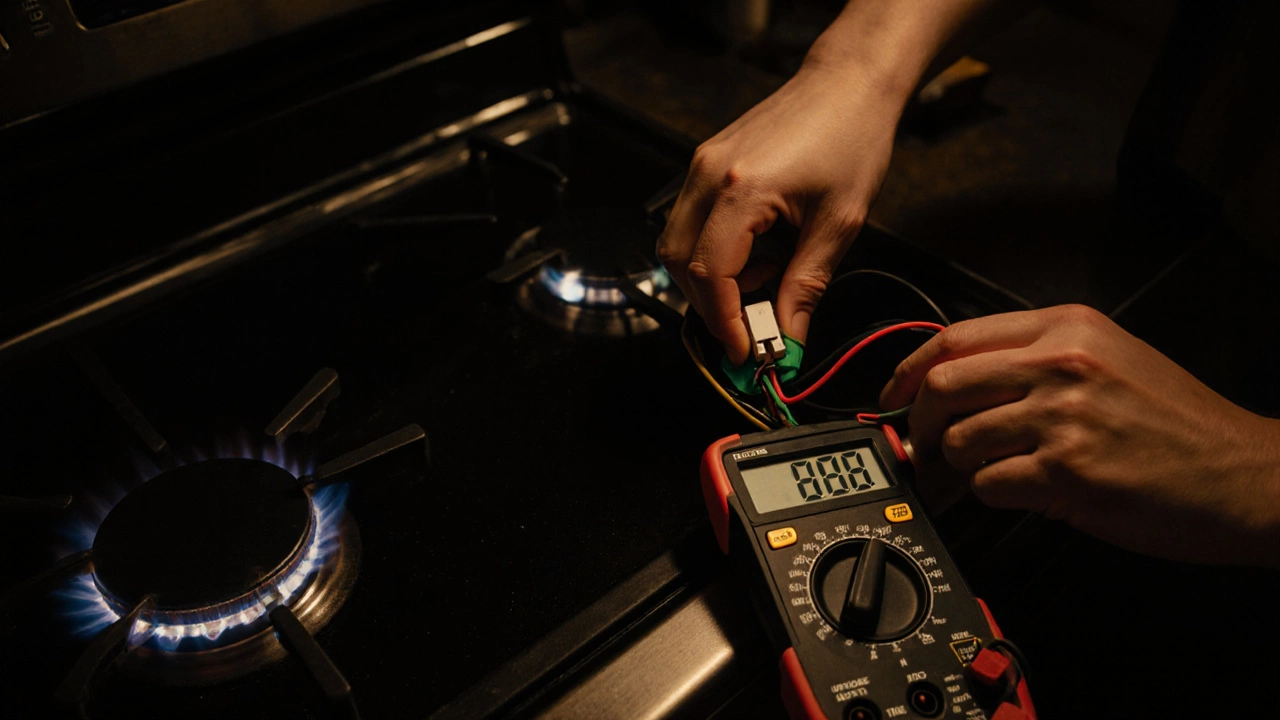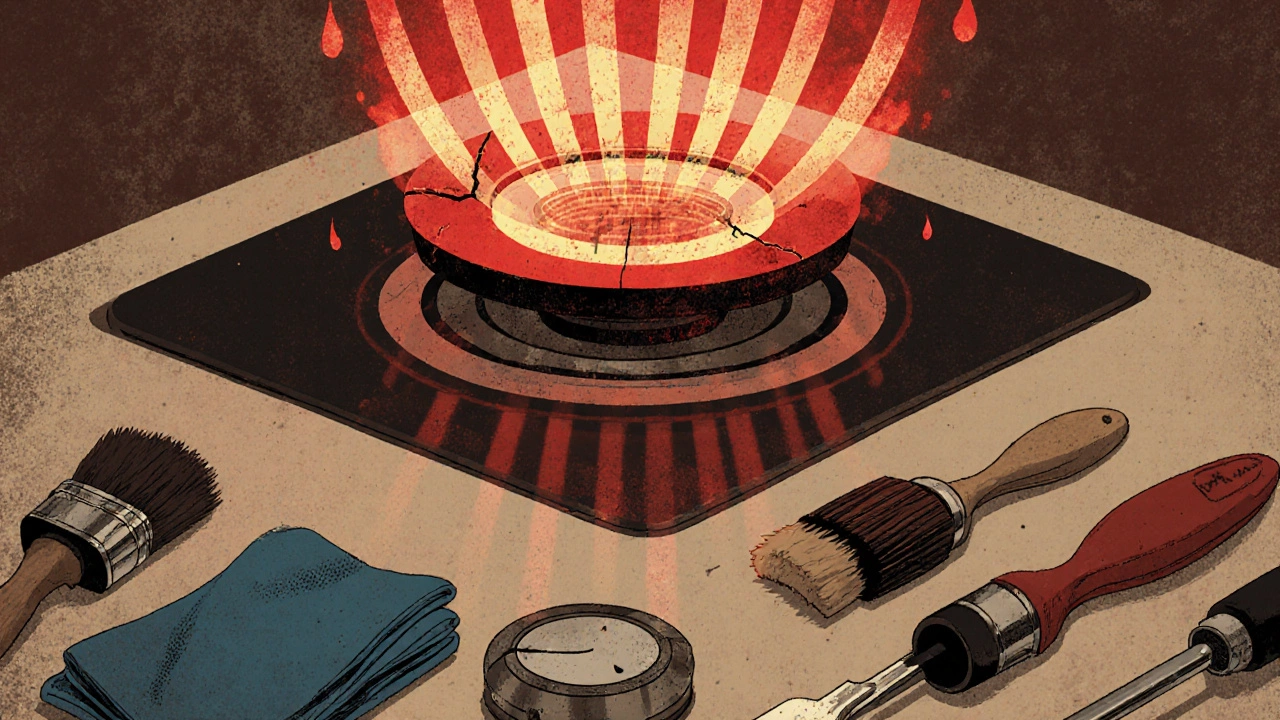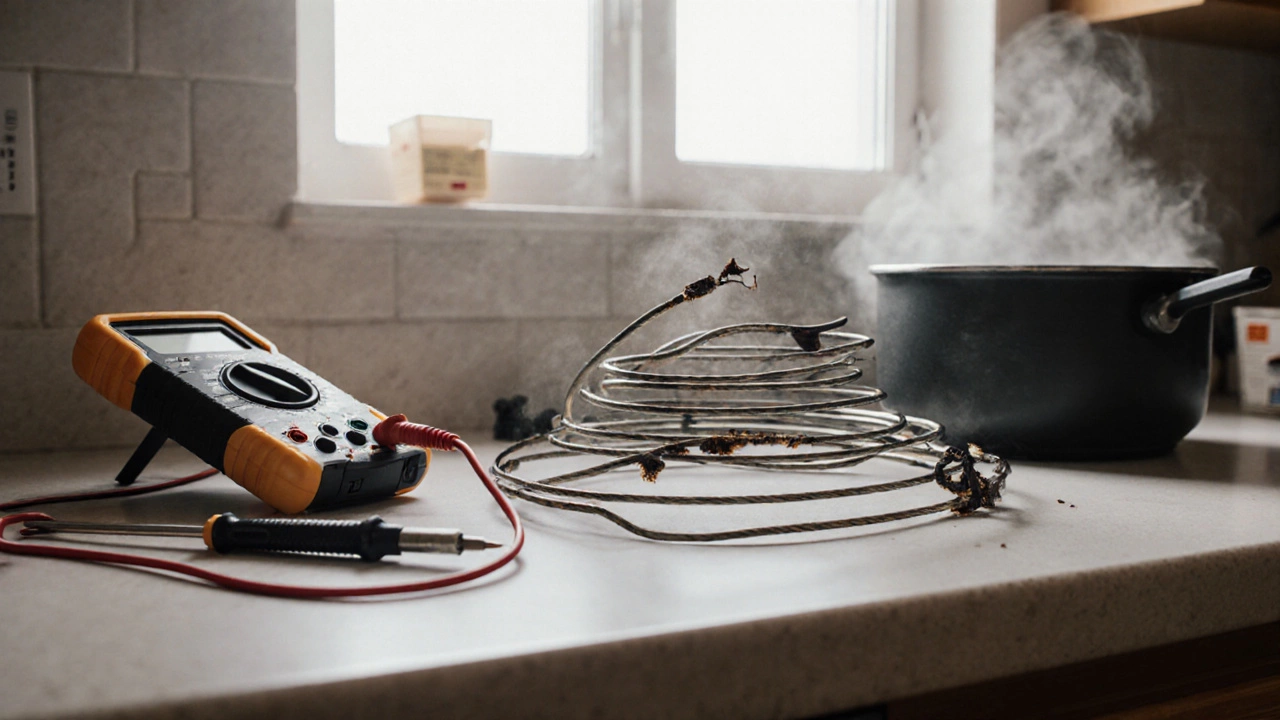Electric Stove Problem Finder
Troubleshoot Your Electric Stove in 3 Steps
This tool helps identify the most common electric stove problems using your symptoms. Get immediate guidance on repairs or when to call a professional.
Step 1: Select Your Symptom
Step 2: Answer Key Questions
Select your answers to get a precise diagnosis.
Step 3: Your Diagnosis
Safety Warning
If you smell burning plastic, see melting insulation, or experience multiple simultaneous failures, turn off power and call a professional immediately.
If your electric stove won’t heat up or keeps turning off mid-cook, you’re not alone. These aren’t rare glitches-they’re the two most common problems homeowners face with electric stoves. And most of the time, you don’t need to call a technician. You just need to know where to look.
The Burner Won’t Heat Up
This is the #1 complaint. You turn the knob, the indicator light comes on, but the coil stays cold. No sizzle, no heat. The first thing to check isn’t the power supply-it’s the heating element itself.
Electric stove elements wear out. They’re designed to last 5 to 10 years, but heavy use, spills, or accidental drops can shorten that life. A broken element looks obvious: the coil might be cracked, sagging, or have a dark, burnt spot where the wire has snapped. Sometimes, it’s not visible. That’s why you need to test it.
Unplug the stove or turn off the circuit breaker. Pull the element out of its socket. Set your multimeter to ohms (Ω). Touch one probe to each terminal on the element. If you get a reading between 20 and 120 ohms, it’s good. If it shows infinite resistance (OL or 1), the element is dead. No reading means no current flow. Time to replace it.
Replacement is simple. Buy the exact model number-your stove’s make and model are usually on a sticker inside the oven door or under the cooktop. Cost? Around $25 to $50. Installation takes 15 minutes. You don’t need tools beyond a screwdriver. Just unplug the old one, plug in the new one, and slide it back into place.
The Stove Turns Off Mid-Cooking
This one’s trickier. The stove works fine for a few minutes, then shuts down. You wait, turn it back on, and it works again-until it doesn’t. This isn’t a power outage. It’s a safety feature kicking in.
The culprit? The thermal fuse or the infinite switch. The thermal fuse is a small, one-time-use safety device that cuts power if the stove overheats. If it’s blown, the stove won’t turn on at all. But if it’s intermittent, the problem is usually the infinite switch.
The infinite switch controls how much power goes to the burner. It’s the dial you turn to set low, medium, or high heat. Over time, the internal contacts wear out. When they do, they can’t hold a steady connection. The stove heats up, the switch overheats, and it cuts power to cool down. Once it cools, it works again-until the cycle repeats.
To test it, you’ll need to remove the control panel. Unplug the stove. Take off the knobs and the screws behind them. Carefully pull the switch out and disconnect the wires. Use your multimeter again. Set it to ohms. Test each terminal pair while turning the dial. If the resistance jumps around or shows no continuity at certain positions, the switch is bad.
Replacing the infinite switch costs $30 to $70, depending on the brand. It’s a bit more work than swapping a coil, but still doable for most homeowners. Just make sure you label the wires before you pull them off. One wrong connection and you’ll fry something else.
Why These Problems Happen So Often
Electric stoves are simple machines, but they’re under constant stress. Every time you boil water or sear meat, the heating elements expand and contract. That repeated thermal cycling fatigues the metal. Spilled sugar, grease, or water can drip into the socket and cause corrosion. Even a small amount of moisture can lead to arcing and premature failure.
Also, many people don’t realize their stoves need cleaning. Built-up residue on the coil or under the glass cooktop traps heat. That heat rises into the control panel and stresses the switches and wiring. A dirty stove isn’t just unhygienic-it’s a fire risk.
Regular maintenance prevents most of these issues. Wipe the cooktop after every use. Clean the coil sockets with a dry brush every few months. Don’t use metal scouring pads on glass tops-they scratch and weaken the surface. And never leave a pot boiling dry. That’s the fastest way to kill a heating element.

What to Avoid When Repairing
Don’t try to fix a broken element with tape or wire. That’s dangerous. Don’t ignore a flickering light or a burner that only works on high. These aren’t minor annoyances-they’re warning signs. A faulty switch can overheat the wiring behind the panel. That’s how house fires start.
Also, avoid cheap knock-off parts. Online marketplaces are full of fake elements that look right but don’t meet safety standards. They might fit, but they’ll overheat, melt the socket, or fail within weeks. Stick to OEM parts or reputable brands like Whirlpool, GE, or Bosch. The difference in price is small, but the safety gap is huge.
When to Call a Pro
There are times when DIY isn’t safe. If the whole cooktop is dead and the breaker keeps tripping, there’s likely a short in the wiring. If you smell burning plastic or see melted insulation behind the control panel, turn off the power and call a technician. Same if you’re not comfortable working with electricity-even a 240-volt stove can deliver a lethal shock if you’re not careful.
Also, if your stove is over 15 years old, consider replacement. Older models use outdated components that are harder to find. Repair costs can add up fast. A new electric stove with modern safety features, precise temperature control, and energy-efficient elements might cost $600 to $1,200-but it’ll last 15+ years and save you money on your power bill.

Real-Life Example: A Cooktop That Just Stopped Working
Last month, a customer in Lower Hutt called because her stove wouldn’t heat. The front right burner was dead. The oven worked fine. She tried different knobs. Nothing. She assumed it was the power supply.
I asked her to check the element. She pulled it out and saw a clear break in the coil. She bought a replacement online for $32. Installed it herself. Cooked dinner that night. No call to a technician. No waiting days for a repair slot. Just a $32 fix.
That’s the story for 80% of electric stove problems. Not magic. Not mystery. Just a worn-out part and someone who knew how to find it.
Quick Checklist: Diagnose Your Stove in 10 Minutes
- Is the burner completely dead? → Test the heating element with a multimeter.
- Does the burner turn off randomly? → Suspect the infinite switch.
- Are multiple burners failing? → Check the power supply or main terminal block.
- Is there a burning smell? → Turn off power immediately. Call a pro.
- Is the stove over 15 years old? → Consider replacement over repair.
Why does my electric stove turn off after a few minutes?
This usually means the infinite switch is failing. The internal contacts wear out and can’t hold a steady connection. When the switch overheats, it cuts power to protect the system. Once it cools, it works again-until the cycle repeats. Replacing the switch fixes this.
Can I replace a stove element myself?
Yes. Most electric stove elements are plug-in and require no wiring. Just unplug the stove, remove the old element, plug in the new one, and slide it back in. It takes less than 15 minutes. Make sure you match the model number exactly.
How do I know if my heating element is bad?
Use a multimeter. Set it to ohms and touch the probes to the two terminals on the element. A good element reads between 20 and 120 ohms. If it shows OL or 1, the element is broken and needs replacing.
Is it worth repairing an old electric stove?
If your stove is under 10 years old and the repair costs less than half the price of a new one, yes. If it’s older than 15 years, or if you’re fixing the same part twice, replacement is smarter. New stoves are more energy-efficient and safer.
What causes electric stove elements to fail early?
Spills that aren’t cleaned, especially sugary or salty liquids, can corrode the element’s terminals. Dropping heavy pots, using metal scrubbers on glass tops, and leaving pans boiling dry also shorten element life. Regular cleaning and gentle use help them last longer.

